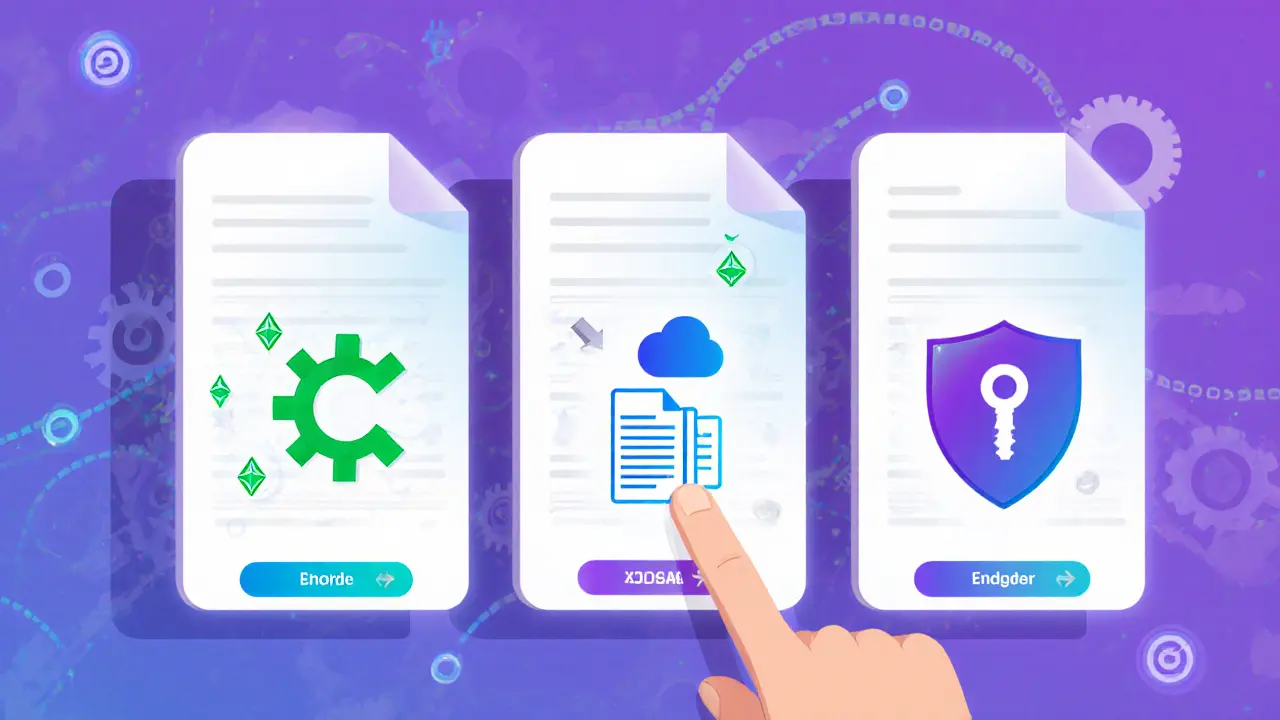DID Validator & Explorer
Enter a DID string (e.g., did:ethr:0x1234abcd) to validate format and extract blockchain details
did: - Protocol prefix indicating a decentralized identifier
ethr - Method name (Ethereum-specific)
0x1234abcd... - Blockchain-specific identifier
Each DID references a DID Document stored on a blockchain ledger that contains public keys and authentication methods
Ever wondered why the phrase “you own your digital self” keeps popping up in blockchain chats? The secret sauce is decentralized identifiers. Unlike usernames or email addresses that live on a company’s server, DIDs let you prove who you are directly on a blockchain, without a middle‑man. This guide walks you through the nuts and bolts of DIDs, how they sit on a ledger, and what you need to know before you start building.
What Exactly Is a DID?
Decentralized Identifier (DID) is a W3C‑standard string that lets an entity create, own, and control a digital identifier without relying on a centralized registrar. The format always starts with did:, followed by a method name (e.g., ethr for Ethereum) and a unique method‑specific string. A DID looks like did:ethr:0x1234abcd....
The key idea is sovereignty: the owner holds a private key that signs actions, and the corresponding public key lives in a DID Document a JSON‑LD document stored on‑chain that lists public keys, authentication methods, and service endpoints. Anyone can fetch the document, verify the signatures, and trust the identifier.
How DIDs Live on a Blockchain
Think of a blockchain as an immutable notebook. When you create a DID, you submit a transaction that writes the DID Document to the ledger. Because the ledger is consensus‑driven, the entry can’t be altered retroactively-perfect for tamper‑evident identity.
Different blockchains provide different trade‑offs. Ethereum offers strong smart‑contract capabilities but charges gas (≈ $0.45 per write in 2023). The XRP Ledger confirms in 3‑5 seconds with negligible fees (< $0.001). Hyperledger Indy is purpose‑built for identity and can handle thousands of DID writes per second in a permissioned setting.
Core Components Inside a DID Document
- Public Keys: Usually ECDSA or Ed25519 keys that prove ownership.
- Authentication Methods: Defines how the holder can sign challenges (e.g.,
authentication: [{"type":"Ed25519VerificationKey2018","controller":"did:ethr:0x...","publicKeyBase58":"..."}]). - Service Endpoints: URLs or URIs where the DID can be used-think “login endpoint”, “credential issuance service”, or “messaging gateway”.
- Proof of Control: Some methods include a
capabilityDelegationorcapabilityInvocationfield to enable delegated authority.
All of these pieces are transparent on the ledger, so any verifier can check them without contacting a central authority.

Popular DID Methods and Their Blockchains
Each blockchain needs its own “method” to translate the generic DID format into concrete on‑chain actions. Here are the three most used today:
- Ethereum (ethr) stores the DID Document in a smart contract and uses the account’s public key as the identifier. Works well with existing dApps and wallets like MetaMask.
- XRP Ledger (xrpl) writes a minimal DID Document to the ledger’s native transaction metadata, offering fast finality and micro‑fee costs. Adopted by the XRP Foundation in 2022.
- Hyperledger Indy a permissioned ledger designed for identity, supporting rich credential schemas and revocation registries. Often used by governments and enterprises.
Connecting DIDs to Verifiable Credentials
Once you have a DID, you can issue Verifiable Credential a tamper‑proof digital attestation (like a diploma or driver’s license) signed by an issuer’s private key. The holder stores the credential in a wallet, and a verifier checks two things:
- The credential’s signature validates against the issuer’s DID Document.
- The holder can present a proof (often a zero‑knowledge proof) that satisfies the verifier without revealing extra data.
Because the verification step only needs the public DID Documents, no centralized database is involved-exactly the privacy advantage that DIDs promise.
Pros, Cons, and a Quick Comparison
| Feature | DIDs (Blockchain) | OAuth/OpenID Connect |
|---|---|---|
| Control | User holds private key; no third‑party issuer. | Identity provider (Google, Microsoft) controls credentials. |
| Privacy | Selective disclosure via zero‑knowledge proofs. | Often share email or profile data. |
| Cost | Transaction fees (variable; cheap on XRPL, higher on Ethereum). | Typically free for end‑users; provider bears infrastructure cost. |
| Scalability | 15‑45 ops/sec on Ethereum; higher on layer‑2 or Indy. | Thousands of auth requests per second. |
| Usability | Requires wallet & key management. | Familiar sign‑in flow; no keys needed. |
| Legal Recognition | Limited (12 countries as of 2023). | Widely accepted worldwide. |
In short, DIDs win on sovereignty and privacy but still lag on mass adoption and ease of use. If you value data minimisation above friction, DIDs are worth exploring.
Step‑by‑Step: Creating and Resolving a DID
- Choose a blockchain and install a compatible crypto wallet (MetaMask for Ethereum, XUMM for XRP, or Indy‑SDK for Indy).
- Generate a new key pair. Most wallets give you a 12‑24 word mnemonic; keep it safe.
- Use the method‑specific CLI or SDK to submit a “create DID” transaction. The tool will encode your public key into a DID Document and write it on‑chain.
- Record the resulting DID string (e.g.,
did:ethr:0xAbCd...). - To resolve, call a DID resolver (e.g.,
https://resolver.identity.foundation/1.0/identifiers/<did>) or use the SDK’sresolve()function. The resolver fetches the on‑chain Document and returns the JSON‑LD. - Verify by checking the
publicKeyfield against the signature of any message you receive.
Developers typically need 80‑120 hours of training to master all moving parts, while end users can get comfortable after a few practice runs with a wallet.
Future Directions and Open Challenges
Researchers predict that by 2026, 40% of DID implementations will combine AI‑driven biometrics with cryptographic proofs. Cross‑chain bridges like Polygon ID’s zk‑proof layer aim to push throughput past 2,000 operations per second, narrowing the gap with OAuth providers.
Key challenges remain:
- Key recovery: Losing a private key means losing the identity. Social‑recovery schemes (guardians, multi‑sig wallets) are evolving but not standardized.
- Regulatory clarity: Only a dozen nations have formal frameworks for blockchain identities; ambiguity hampers enterprise rollout.
- Revocation: While verification scores 9.2/10, revoking a compromised DID scores under 5/10 because the ledger is immutable.
When those pieces fall into place, DIDs could become the “missing link” between Web3’s trust layer and everyday login experiences, potentially serving billions of users.
Quick Checklist for Deploying DIDs
- Pick a DID method that matches your performance and regulatory needs.
- Use a wallet that supports social recovery if you target non‑technical end users.
- Store the DID Document off‑chain only if you need mutable data; otherwise keep it on‑chain for tamper evidence.
- Integrate with a Verifiable Credential library that follows the W3C data model.
- Plan for key rotation and revocation pathways early.
Can I use a DID without a blockchain?
A DID needs a trust anchor. Most specifications require a ledger-public or private-so a pure off‑chain DID would break the verifiable‑by‑anyone guarantee.
How secure are DIDs compared to passwords?
Because DIDs rely on asymmetric cryptography, a compromised password can be guessed, but a private key can’t be brute‑forced with current computing power. The real risk is losing the key, not it being hacked.
Do DIDs work on mobile devices?
Yes. Wallet apps like MetaMask Mobile, Trust Wallet, and XUMM let you generate and present DIDs directly from your phone, although UX is still improving.
What happens if a blockchain forks?
W3C specifications say a DID persists across forks as long as the DID Document remains on the longest‑chain. Some methods add a stateProof to guard against accidental splits.
Is there a universal resolver for DIDs?
The DID Resolver 1.0 spec defines a generic HTTP API, and projects like resolver.identity.foundation provide a public endpoint that works for most registered methods, but not every blockchain has a live resolver yet.


Elizabeth Chatwood
Yo DIDs are the future